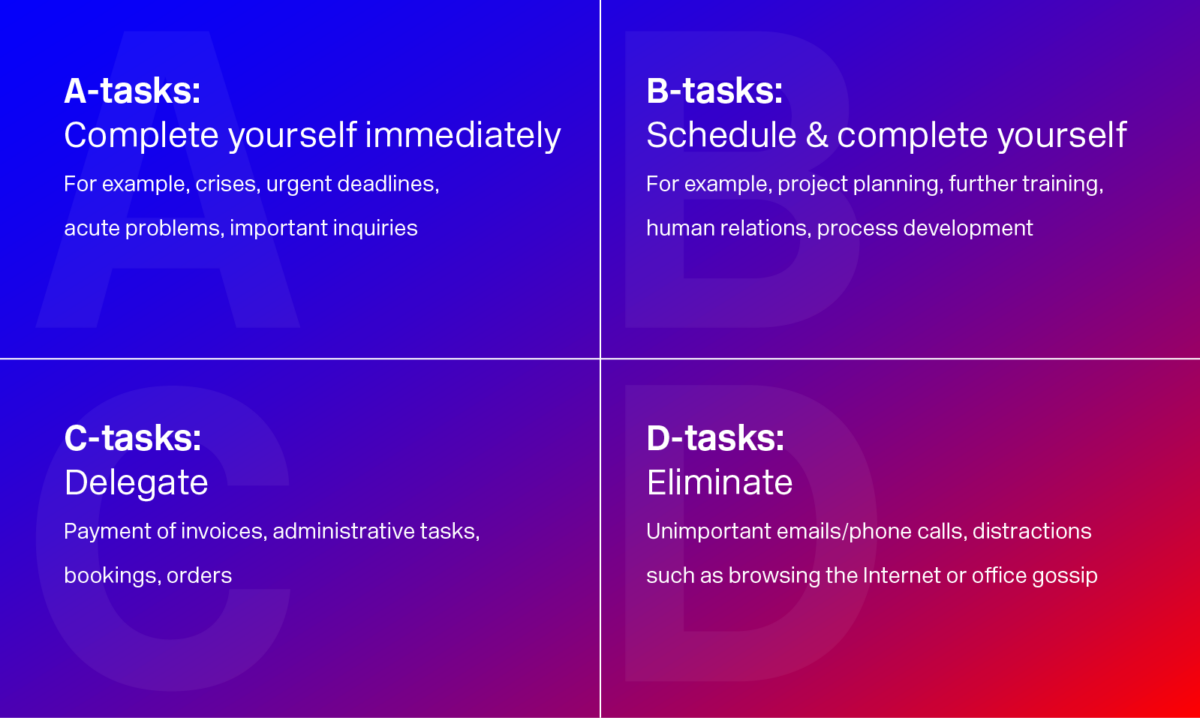You’re running out of time: why not try the Eisenhower Matrix?
You’re in the middle of planning an important project, but the phone keeps ringing and one urgent email after the other pings in your inbox. Sound familiar? The Eisenhower Matrix shows you how to set the right priorities.

What is the Eisenhower Matrix?
The Eisenhower Matrix is – surprise, surprise! – named after the former U.S. president Dwight D. Eisenhower, who used a simple box to structure and visualize his tasks in order to accomplish his goals more effectively. To this end, he categorized them according to how urgent and important they were and assigned them to one of four quadrants:
- A-tasks: important and urgent.
- B-tasks: important but not urgent.
- C-tasks: not important but urgent.
- D-tasks: neither important nor urgent.
“I have two kinds of problems: the urgent and the important. The urgent are not important, and the important are never urgent.”
What do the four quadrants mean?
To prioritize tasks successfully, it is essential to assign them to the right quadrants. For this purpose, you need to answer the following two questions:
- Urgency: What would happen if I completed the task later?
- Importance: Can the task also be taken care of by someone else, for example one of your employees?
According to the Eisenhower Matrix, you should take the following actions for tasks that have been assigned to the various quadrants:
#1 Tasks in the A-quadrant:
These tasks are the most urgent and at the same time deemed the most important for you or your company. You need to act quickly with such tasks and complete them yourself without delay. They constitute challenges, e.g. a sudden project crisis, pressing questions from customers, or an urgent email that has to be sent.
#2 Tasks in the B-quadrant:
The B-quadrant contains important tasks that are to be completed over a longer period of time, such as developing a content marketing strategy or planning a social media campaign.
The key here is to not put off B-tasks for too long. Although they don’t have to be completed immediately, you should at least designate some time for them in the near term.
#3 Tasks in the C-quadrant:
C-tasks are ones that need to be completed promptly. However, you don’t have to take care of them yourself. They can thus be delegated to someone else. For example, the office management team can deal with ordering more office supplies.
#4 Tasks in the D-quadrant:
Tasks that are neither important nor urgent can be thrown right in the trash or at least archived. Long email threads where you’ve been needlessly cc’d would be an example. You shouldn’t waste any time on this kind of task.

Prioritizing made easy thanks to the Eisenhower principle
A big advantage of the Eisenhower Box becomes immediately apparent when you look at its structure: its simple decision-making grid is easy to understand and use. By categorizing tasks this way, you can quickly identify time wasters, optimize your time management, and increase your efficiency. Once you have prioritized pending projects, you can also better involve employees or take pressure off them.
The Eisenhower Box: too simple a concept?
The Eisenhower method for improving time management is mainly popular due to its simplicity. However, if you don’t judge a task appropriately in terms of its importance or urgency and assign it to the wrong quadrant as a result, it can become problematic. It is often difficult to recognize what is actually important because it’s usually a matter of subjectivity. What may be a top priority for one person may be insignificant in someone else’s eyes. Focal areas should therefore be clarified within your company – for example using efficient collaboration tools.
The Eisenhower Box may also not be ideal when there are too many tasks to take care of in a single department, since it will be difficult to categorize them and also potentially result in too many of the tasks falling upon one person. You should therefore exercise caution rather than applying the model strictly mechanically.
Save time by cleverly prioritizing
For many, effective time planning is one of the biggest challenges of day-to-day agile business. Its simplicity makes the Eisenhower Box a convenient method for reorganizing your time management and using the freed-up capacities for new ideas and projects – or simply to recharge your batteries. You just have to be careful not to let this simplicity lead to tasks being categorized without thought or other employees being overburdened.
If you don’t want to miss any other exciting topics, then subscribe to our content newsletter now and stay up to date.





